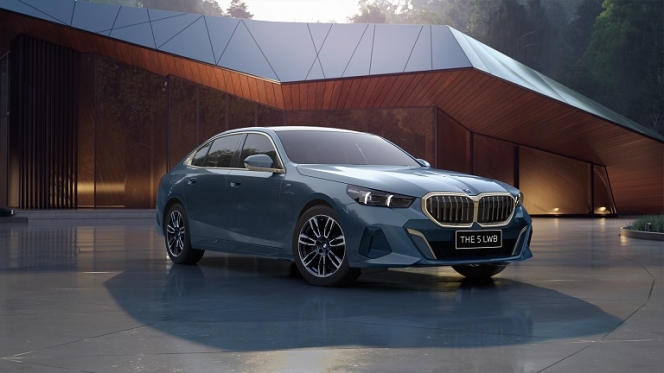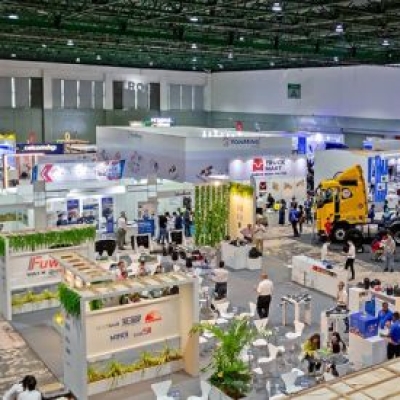BMW Group India Posts Highest-Ever Sales In First Nine Months
- By MT Bureau
- October 11, 2025

BMW Group India is reporting record-breaking sales for the first three quarters of 2025 (calendar year), marking its strongest performance in the market to date. Between January and September, the company delivered 11,978 cars and 3,976 motorcycles. The BMW brand itself contributed 11,510 car sales, while MINI accounted for 468 units. This impressive growth trajectory was particularly strong in the third quarter, which saw a 21 percent year-on-year sales increase and set a new record for both the quarter and the month of September, fuelled by festive demand and favourable market conditions post GST 2.0.
A significant driver of this success is the company's electric vehicle portfolio, which solidifies its position as the country's leading luxury EV brand. Sales of electric BMW and MINI models surged by an astounding 246 percent, with 2,509 units delivered. This pushed the EV contribution to total car sales to 21 percent, led by the iX1 and the flagship i7 sedan. This momentum also allowed BMW Group India to surpass a cumulative total of 5,000 electric vehicle deliveries during the third quarter. The company supports its six electric cars and two electric scooters with a comprehensive charging ecosystem, including complimentary Wallbox chargers, a fast-charging dealer network and access to over 6,000 public charging points.
Further defining the sales landscape is the exceptional demand for long wheelbase models, which grew by 169 percent to 5,720 units. These models, including the 7 Series, 5 Series, 3 Series and the iX1, now constitute half of all car sales. The 3 Series emerged as the highest-selling BMW sedan, praised for its spaciousness and powerful engine, while the 7 Series continues to be the segment's most desirable ultra-luxury limousine.
The Sports Activity Vehicle (SAV) segment also remains a cornerstone of BMW's dominance, with 7,040 units sold, a 19 percent increase that represents 59 percent of total sales. The X1 was the highest-selling model across the entire portfolio and within its segment, followed by the flagship X7. Meanwhile, the MINI brand delivered 468 units between January to September 2025 and saw the Cooper S model achieve a sales growth of over 90 percent. BMW Motorrad sold 3,976 motorcycles, with the G 310 RR and the 1300 GS / GSA models leading their respective categories.
Hardeep Singh Brar, President and CEO, BMW Group India, said, “BMW Group India has continuously succeeded in attaining high growth throughout 2025. The highest-ever sales in first nine months as well as in the third quarter reflect our unparalleled focus on customer centricity. The strong product offensive coupled with excellent aftersales services, personalised brand engagements and financial offers have spurred demand significantly. Our long-term strategy is aimed at successfully unlocking the potential of luxury car market and increasing market share while maintaining the core of JOY and Sheer Driving Pleasure we promise. The order bank remains healthy, and we are confident of closing the year with best-ever sales once again.”
- Maruti Suzuki India
- Swivel Seat
- United Nations
- TRUEAssist Technology
- NSRCEL-IIM Bangalore
- Hisashi Takeuchi
- Naina Padaki
Maruti Suzuki Launches WagonR Swivel Seat For Inclusive Mobility
- By MT Bureau
- December 17, 2025

Maruti Suzuki India has introduced a swivel seat option for the popular WagonR hatchback. The feature is designed to assist senior citizens and persons with disabilities by providing easier access to the vehicle.
The initiative aligns with the Suzuki Group slogan 'By Your Side' and the United Nations’ Sustainable Development Goal 10 regarding the reduction of inequality.
The solution was developed in collaboration with TRUEAssist Technology, a Bengaluru-based startup, under Maruti Suzuki’s incubation programme with NSRCEL-IIM Bangalore.
The swivel seat is available as a retrofitment kit at Maruti Suzuki Arena dealerships. It can be installed in new WagonR models or retrofitted into existing vehicles. The project will initially launch at 200 dealerships across 11 cities, with plans to scale based on customer response.
Hisashi Takeuchi, Managing Director & CEO, Maruti Suzuki India, said, “Swivel seat will make daily travel more convenient for senior citizens and persons with disabilities. WagonR is among the top 10 selling models* in India and is ideal to offer this accessibility feature to a wider audience. This initiative reflects our vision of inclusive mobility and reinforces our commitment to customer-focused solutions that empower people with dignity, independence, and confidence in their everyday journeys. It fully aligns with our motto to deliver ‘Joy of Mobility’ to as many people as possible.”
Naina Padaki, Founder of TRUEAssist Technology, stated, “We are truly pleased to collaborate with India’s leading passenger vehicle manufacturer, Maruti Suzuki, to bring our assistive mobility solution to a wider audience. Working with the R&D engineers of Maruti Suzuki has been a delightful experience, and it is inspiring how deeply they think of the customers in every aspect. By integrating our innovation into a model loved by the masses, we can ensure that inclusive mobility becomes a mainstream reality and reaches more families across India.”
The WagonR swivel seat kit has been tested by the Automotive Research Association of India (ARAI). The installation does not require modifications to the car’s structure or core functions. The swivel seat is supplied with a three-year warranty.
Tata Sierra Clocks Over 70,000 Bookings On Day 1
- By MT Bureau
- December 17, 2025

Tata Motors, one of the leading passenger vehicle manufacturers in the country, has announced that its recently launched iconic Tata Sierra SUV has garnered over 70,000 confirmed bookings on the first day of the booking opening. The SUV prices start at INR 1.14 million and goes up to INR 2.12 million for the top-spec model.
The company claims it also received an additional 135,000 customers submitting their preferred configuration as they progress to complete booking formalities.
Vivek Srivatsa, Chief Commercial Officer, Tata Passenger Electric Mobility, said, “We sincerely thank our customers for this overwhelming response which reaffirms the legendary status of the Tata Sierra. True to its legacy of redefining norms, the Sierra has pioneered a new category: the premium mid-SUV. Harnessing a deep understanding of evolving consumer aspirations, it reimagines what a mid-size SUV can be. By enriching every dimension – space, comfort, luxury, safety, and everyday usability, the Sierra elevates the segment to an entirely new benchmark. The Sierra is more than a vehicle – it stands as a symbol of progress, individuality and aspiration.”
The Tata Sierra was launched on 25 November, and is pipped as a premium mid-SUV and is available in three powertrain options – the 1.5L Kryojet Diesel, the 1.5L TGDi Hyperion petrol and the 1.5L NA Revotron petrol.
Hyundai Nexo Secures 5-Star Euro NCAP Safety Rating
- By MT Bureau
- December 16, 2025

South Korean auto major Hyundai Motor Company has announced that its all-new Hyundai Nexo fuel-cell electric SUV has bagged 5-star crash test rating in the latest Euro NCAP safety assessment.
The Nexo, Hyundai’s hydrogen fuel-cell electric SUV, emits only water vapor and is central to the company’s push for zero-emission mobility. The top rating follows five-star Euro NCAP results for the Ioniq 5, Ioniq 6 and Ioniq 9. The rating validates Hyundai’s performance in crash protection and its suite of safety and driver-assistance technologies.
Euro NCAP, Europe’s independent organisation for evaluating vehicle safety, assesses vehicles across four areas: adult occupant protection, child occupant protection, protection of vulnerable road users and safety assistance technologies.
The new Hyundai Nexo achieved results across all four areas, including:
90 percent in Adult Occupant Protection.
85 percent in Child Occupant Protection.
In adult occupant tests, the passenger compartment remained stable in the frontal offset test, with protection of the knees, femurs, and all critical body regions for both driver and passenger. The Nexo performed well in the full-width rigid barrier test, achieved maximum points in the side barrier test and provided effective far-side occupant protection via its centre airbag. Whiplash protection for both front and rear seats was rated as good in rear-impact evaluations.
Child occupant protection performance was strong. The six- and 10-year-old dummies showed protection in all critical body areas in both frontal and side-impact tests, earning maximum points.
Additional safety features noted by Euro NCAP include an advanced eCall system and post-crash secondary impact prevention technology.
This achievement underlines Hyundai’s long-term commitment to hydrogen technology and safety innovation. The previous generation NEXO was the first fuel-cell electric vehicle tested by Euro NCAP in 2018, also achieving a five-star rating under the standards at that time.
JSW MG Motor India Introduces All-New Hector SUV At INR 1.19 Million
- By MT Bureau
- December 15, 2025

JSW MG Motor India has introduced the all-new MG Hector SUV featuring a revised exterior with new front and rear bumper designs, a new grille design and new alloy wheels at prices starting INR 1.19 million (ex-showroom) for limited units. The SUV comes in two new colours – Celadon Blue and Pearl White.
The interiors feature a Dual Tone Ice Grey Theme in the 5-seater trim and Dual Tone Urban Tan for the 6 and 7-seater trims. Exterior details include the new Aura Hex Grille, a hexagonal structure that symbolises strength and precision. New Aura Sculpt Bumpers at the front and rear deliver a muscular, assertive stance and also the Aura Bolt Alloy Wheels.
The all-new Hector's infotainment system, featuring a 14-inch HD portrait touch screen, receives a performance boost through Smart Boost technology. The system features the i-SWIPE Touch Gesture Control, enabling intuitive multi-touch operations for AC, music and navigation. Further convenience is provided by the Digital Bluetooth Key and Key Sharing capability along with Predictive Maintenance Alerts, Remote AC Control. A Full Digital Cluster with a 17.78 cm Embedded LCD Screen provides a driver interface.
Anurag Mehrotra, Managing Director, JSW MG Motor India, said, “The Hector was our maiden nameplate and quickly became synonymous with the MG brand, emerging as one of India’s most loved SUVs with 150,000 customers since its debut. With the All-New MG Hector, we take this legacy a notch higher by enhancing its design, comfort, and technology, offering an unmatched value proposition. We believe truly advanced mobility should not be an exclusive luxury reserved for the few. With this superior package, The All-New MG Hector will further democratize technology while setting a new benchmark for what a premium SUV can deliver.”
The new Hector also features a 360deg HD Camera with Wheel View, offering surround visibility along with tyre-level perspective. In terms of standard it gets ABS, EBD, ESP, TCS, Hill Hold Control and Brake Assist. The SUV is powered by a 1.5L Turbocharged Petrol engine (CVT & MT) offering 143 PS Power and 250 NM Torque.
Launched in 2019 as India’s First Internet Car, the MG Hector includes features such as a dual-pane panoramic sunroof, a 35.56 cm (14-inch) HD infotainment system, 8-colour Ambient Mood Lighting, and MG’s advanced i-SMART connected technology with 70+ features, and an advanced ADAS suite. Further features include Push Button Engine Start/Stop with a Smart Key and Anti-Theft Immobilisation, automatic powered tailgate, air purifier with PM 2.5 filter, rain sensing wipers, Remote Control for Audio, AC & Mood Light in i-Smart App and front parking sensors.
The prices for the diesel variant of the all-new Hector SUV will be announced next year.






Comments (0)
ADD COMMENT